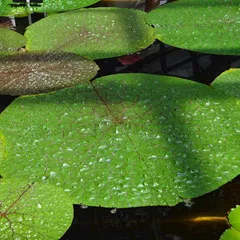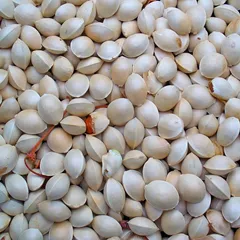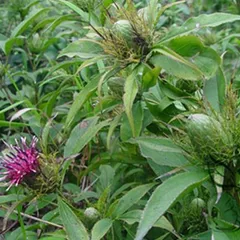Spleen Deficiency
The information provided here is not a replacement for a doctor. You shouldn't use it for the purpose of self-diagnosing or self-medicating but rather so you can have a more informed discussion with a professional TCM practitioner.
At a glance
Preliminary reading: What is a pattern?
Diagnosis
Common symptoms: Edema Tiredness Dull face Sore back Depression and seven other symptoms
Pulse type(s): Weak (Ruo)
Tongue coating: Thick white coating
Tongue color: Pale
Pathology
Spleen Deficiency is a pattern of disharmony in Chinese Medicine.
Chinese Medicine views the human body as a complex system that tends toward harmony. A pattern of disharmony is a disorder that prevents that harmony from occurring.
Patterns give rise to symptoms that may at first glance seem unrelated from a Western standpoint but that actually make a lot of sense when one understands Chinese Medicine theory. For instance here Spleen Deficiency gives rise to such diverse symptoms as sticky vaginal discharge, tiredness, depression and cold limbs (as well as eight others).
To diagnose a pattern, analyzing a patient's pulse as well as their tongue is common practice. In the case of Spleen Deficiency patients tend to exhibit weak (Ruo) pulses as well as a pale tongue with thick white coating.
Patterns aren't exactly the Chinese Medicine equivalent to Western diseases, they're rather the underlying causes behind diseases or health conditions. Here Spleen Deficiency is thought to sometimes induce conditions such as abnormal vaginal discharge.
Diagnosing Spleen Deficiency
Diagnosing a pattern in Chinese Medicine is no easy feat and should be left to professional practitioners. In particular one has to know how to differentiate between different types of pulses and tongue coatings, shapes and colors as well as learn to read from a long list of seemingly unrelated symptoms.
Pulse type(s): Weak (Ruo)
Tongue coating: Thick white coating
Tongue color: Pale
Main symptoms: Edema Tiredness Dull face Sore back Depression Cold limbs Amenorrhea Weak Limbs Loose stools Poor appetite White vaginal discharge Sticky vaginal discharge
Treating Spleen Deficiency
Herbal formulas used to treat Spleen Deficiency



The top herbs in Bu Zhong Yi Qi Tang are Milkvetch Roots (Huang Qi), Atractylodes Rhizomes (Bai Zhu) and Ginseng (Ren Shen)
Bu Zhong Yi Qi Tang
Source date: 1247
Number of ingredients: 10 herbs
Key actions: Tonifies Qi of the Spleen and Stomach (Middle Burner). Raises the Yang. Detoxifies. Lifts what has sunken.
Formula summary
Bu Zhong Yi Qi Tang is a 10-ingredient Chinese Medicine formula. Invented in 1247, it belongs to the category of formulas that tonify Qi.
Besides Spleen Deficiency, Bu Zhong Yi Qi Tang is also used to treat Qi Deficiency or Qi Collapsing or Qi Sinking.



The top herbs in Yi Huang Tang are Yam (Shan Yao), Foxnut Seeds (Qian Shi) and Ginkgo Nuts (Bai Guo)
Yi Huang Tang
Source date: 1826 AD
Number of ingredients: 5 herbs
Key actions: Strengthens the Spleen. Dries Dampness. Clears Heat. Stops vaginal discharge.
Formula summary
Yi Huang Tang is a 5-ingredient Chinese Medicine formula. Invented in 1826 AD, it belongs to the category of formulas that secure irregular uterine bleeding and stop vaginal discharge.
Besides Spleen Deficiency, Yi Huang Tang is also used to treat Damp-Heat or Spleen Yang Deficiency.



The top herbs in Wan Dai Tang are Atractylodes Rhizomes (Bai Zhu), Yam (Shan Yao) and Ginseng (Ren Shen)
Wan Dai Tang
Source date: 1826 AD
Number of ingredients: 10 herbs
Key actions: Tonifies the Middle Burner. Removes Dampness. Stops vaginal discharge. Strengthens the Spleen.
Formula summary
Wan Dai Tang is a 10-ingredient Chinese Medicine formula. Invented in 1826 AD, it belongs to the category of formulas that secure irregular uterine bleeding and stop vaginal discharge.
Besides Spleen Deficiency, Wan Dai Tang is also used to treat Damp-Phlegm in the Uterus.
Special highlight: the link between abnormal vaginal discharge and Spleen Deficiency

Atractylodes Rhizomes (Bai Zhu) is the key herb for Wan Dai Tang, a formula used for abnormal vaginal discharge caused by Spleen Deficiency
Typical symptoms for abnormal vaginal discharge caused by Spleen Deficiency: Edema Tiredness Dull face Sore back Depression Cold limbs Amenorrhea Weak Limbs Loose stools Poor appetite White vaginal discharge Sticky vaginal discharge
Recommended herbal formulas: Wan Dai Tang, Bu Zhong Yi Qi Tang, Yi Huang Tang
This pattern can be further divided into Spleen Qi Deficiency, Spleen Yang Deficiency and Spleen Qi Sinking. The first one can develop as a consequence of the latter two if they linger for a while without proper treatment. Spleen Yang Deficiency can also lead to Kidney Yang Deficiency.
The typical symptoms are excessive and continuous vaginal discharge with a white or pale yellow color. Normally there is no smell. The consistency is sticky, which suggests Dampness (which is the case here) or Read more about abnormal vaginal discharge
